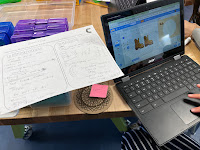Maker Ed Exploration of A.I.
For the last several years I've wrapped up my 7th grade CS classes with a big robotics build. Students design, construct and code their own Raspberry Pi robots in teams and then showcase their work at our exhibition. This year's teams really stepped it up and requested to learn all sorts of new tools, libraries and/or programming in order to increase the interactivity of their robots. From chat bot technology to voice activated translators, several teams had great ideas about how A.I. could help them innovate to help others. And in the process of learning how to integrate A.I. capabilities into their code, students also learned about the limitations, challenges and ethical considerations with current A.I. technology. Our A.I. requirements Since I had never integrated A.I. into my programming before either, I was as much a novice as the students. So we decided that each team interested in A.I. capabilities would use the same library (whether it exactly fit their original proj...


.JPG)




